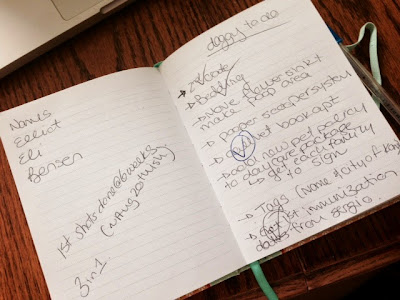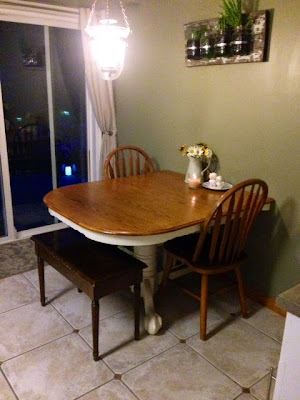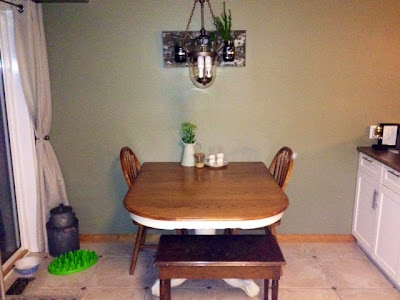Saturday (Day 1)
I sometimes feel an urge to spend a few dollars on something small and not really necessary. Not like, "Oh, I really want that shiny thing", more like "I want to go buy $10 in something, I wonder what is around". It's strange. I wonder if I spend money to renew the association between money and primary/tangible reinforcers? I don't do much of my "life sustaining" spending, so maybe I should grocery shop more? Would this help?
Conditioning Clapping as a substitute reinforcer
**I should do this as an educational exercise for myself**
With each step, keep the previous step as well - even when you move on, you don't stop practicing the step(s) before
- Train the dog to accept clapping - train it as a behaviour (they don't leave, get bored, etc)
- Be sure they learn that they don't need to do anything "Just sit there and stare at me"
- Clap, feed, pause, clap, feed, pause
- Then mix into behaviours - clap, feed, sit, feed, down, feed, clap feed, etc
- Continue until its clear that the clapping is accepted by the animal - they watch/listen and don't offer behaviour or wander away
- Just like any other behaviour, when they're reliable in a controlled environment, start taking it to new places
- Weeks and weeks of clapping and treating in with other behaviours - varies greatly based on frequency of training, animal's unique background, etc
- THEN - continue using clapping as a behaviour in regular training
- introduce an easy, well established behaviour, followed by clapping, feed
- Sit, clap, feed OR Sit, click, clap, feed (if clicker is used) - use different behaviours, not just Sit.. switch up between other easy behaviours to generalize it as a skill
- Do this very occasionally. Once or twice per session, others all get immediate food.
- THEN
- Easy, well established behaviour, followed by clapping. Move onto cuing the next behaviour,
- Only max 3x per session
- Most of the time food still comes after behaviours
- THEN
- introduce clap-feed after harder well established behaviours, then transition to just clap alone - hard behaviours are probably hard because they're chains in some way
- gradually use clap alone more than max 20% of a session average
- THEN
- Only max 3x per session
- THEN
- THEN - continue using clapping as a behaviour in regular training
- Example session: 15 minutes - 10 minutes of serious guide dog work, then "break" from formal work to work on "fun" things for last 5 minutes, and in the midst of it all, adding reinforcement substitutes throughout the session
- With animals who have learned several (4 or 5) secondary reinforcers already, you can add more at the same time. At first, introduce them one at a time.
- With animals who have more than one trainer, teaching the new behaviour is best done with one trainer to start with. Once they know clap as a behaviour, everyone can use it. Original trainer will keep moving up the steps, then as each step becomes reliable, other trainers can start to use it gradually. They need to establish it for themselves, but it will go much more quickly for the next trainer.
- Rules: (clapping as example)
- Never use clapping after two consecutive behaviours
- Don't use clapping twice in a row if you have other non-foods to choose from (sit, clap, down, feed, sit, feed, touch, conditioned tactile,...)
- Always ask for a behaviour followed by Primary MORE than clapping (Sit, clap, down, feed, touch, feed, sit, clap -- will pattern and weaken behaviours)
- Use clapping as a behaviour more often than as a reinforcer
- Never use clapping after two consecutive behaviours
Four options of reinforcers: Food (nutrition), Treat (not nutritionally complete), Learned, Toy (that you don't think you've conditioned)
- Choosing takes experience as a trainer to know which one to choose
- There's nothing that is ALWAYS a reinforcer for any individual animal - illness, etc -- so establish a variety of reinforcers so you have options
- Variable schedule: Pay attention to what the science says. Variable schedules don't make behaviour stronger, they just make it more resistant to extinction
- Allows you to work a longer duration without treats
??? You said you can change duration of behaviour and that's not variable reinforcement. Explain? Is teaching heeling with 1 step, then 2 steps, etc a continuous schedule? What about when you get to 30 or 40 steps? Is this still continuous? Huh?
??? Is a variable schedule not cue, beh, cue, beh, reward, cue, beh, etc? How is this different from step 4: using cues as reinforcers ?... what does science call a variable schedule, then?
- Re frustration- he doesn't purposely introduce frustration, trains without as much as possible which creates confident animals who can then cope with new/strange environments even if some frustration does happen
- This is similar to the idea of training errorlessly to confidence and fluency, then the behaviour will generalize easily to new environments?
Toys:
- The action is the reinforcer. What action is the dog enjoying with the object? ie: ball - chewing is a reward, so a concrete ball wouldn't be reinforcing
- Figure out what action is reinforcing to use toys more effectively
- To condition toys: "Here's a toy, now PLAY"
- Presentation of the toy is a LEARNED reinforcer. Let them play/chew/chase, or it won't be a reinforcer.
- ??Can the presentation of the ball be conditioned to be a reward even without following it with play? Of course it can. So what about presenting food without eating it?
- Analogy: Doors are primary reinforcers - no they're not, the access to the area the door provides is. The door that leads somewhere fun is reinforcing. the closet door is not.
- ??? Some dogs have many motivations for playing with toys: chase, chew, tug,... yes?
- is the duration of the posession of the ball part of the reward for reiker, and why he can drop easier when the ball is farther away?
- ??Is there an issue with conditioning secondary reinforcers with one primary, then following with a different reinforcer?
- in the right condition, with the right animal, he would, but he wouldn't teach it that way. If the dog likes them equally, there is the potential to mix them. Every animal has a priority, so it's a dangerous thing to do unless you REALLY know your dog's hierarchy of reinfforcement. You can inadvertently end up making something seem less reinforcing by the way you use it. You can get away with it if you do it well and carefully, exceeding expectations is less dangerous. Once you teach a dog to accept reinforcement variety, they're much more willing to accept a variety without frustration or disappointment.
**I need to start working archie teaching new behaviours with tug as a reward**
- Expectations can be taught and changed. Teach the dog to expect all the reinforcers you need/want to use so the dog will be reinforced by what you use!!!
- ???Exceeding expectations can have postive unexpected results a la Chirag single trial learning?
- even if the dog loves the toy, if they're in pain it may not be --- malinois exceptions. lol
- ***Archer's ball play was diluted? Shorter hand-throws were not as valuable as longer ones, so without recharge, it's become less valuable. Fix it by playing short throw then long throw x500**
- For Raegan: Ken says "If it's working, you're doing it right"... a la raegan
- Delta - car example - ding to tell you if you don't turn off lights, car will be dead. He is never happy when he hears it. I am, since I don't have a reminder and my car has died several times. Thoughts?
- ??In the hyena example, would there have been a difference if she'd just recued without the ahahah?
- ??Time outs: If the dog is tethered, jumps, you move away, dog settles, you move closer... Is this a time out situation? Fall out? Positive reinforcement? WTF?
- ???How do you use an LRS when you're also using delayed reinforcement for competition???
- the lrs is effective when the dog is looking at you for feedback. they can't tell the difference between "waiting for a longer duration behaviour" vs "waiting to give LRS when they mess up". Use redirection insteada of LRS in these situations, but if you're using it all the time, you may reinforce the unwanted behaviour, so look at the longer term strategy of problem solving to chance the dog's motivation for the behaviour. If the dog is not looking at you for feedback, you CANNOT USE an LRS
- the lrs is effective when the dog is looking at you for feedback. they can't tell the difference between "waiting for a longer duration behaviour" vs "waiting to give LRS when they mess up". Use redirection insteada of LRS in these situations, but if you're using it all the time, you may reinforce the unwanted behaviour, so look at the longer term strategy of problem solving to chance the dog's motivation for the behaviour. If the dog is not looking at you for feedback, you CANNOT USE an LRS
- ??Jumping on people - LRS with tether? IS this a thing?
- **whats the difference between DRA for sitting while backing away to extinctionify jumping, and LRS, and time out?***
- When the animal is engaged in something self reinforcing, the LRS is not an effective tool
- DRI - especially useful for aggression
- DRO - similar to nilif? Waiting for the dog to do something you want before giving it something you're going to give it anyway?
- DRL - click to calm's shaping away from aggression. This is the part i don't like, i think, and ken thinks its dangerous without a really skilled trainer, but he saw emma do it well - he realized that he does use it all the time, for cooperating in their own health care. In the early stages, he's reinforcing them when they're a bit less fidgety, eventually working up to stillness if the animal is always difficult or struggling, then struggles LESS, if you're good at it, you can shape calm
- ???emma parson's method of DRL in aggression, better than not putting the dog over threshold to begin with? :S
SUNDAY (Day 2)
Problem solving: Determining the cause
- 8 categories:
- environmental - weather, changes in the facility (rearranging furniture in home), prop changes, public activity
- social - dominance/submissiveness, aggression, competition, sexual activity
- psychological - boredom, neurotic/aberrant behaviour
- Physical - health, body capabilities (changes in sight, flexibility, etc)
- Trainer - skill level, basics (cues, marker, reinforcers), emotions, attitude
- session use - planning, number of sessions, frequency of sessions, pacing, balance of reinforcement (where reinforcement usually comes from - indoors/outdoors, time of day, location, etc)
- regression - normal part of the learning curve (learn a whole bunch then forget a little)
- desensitization - an ongoing process that never ends. you can never desensitize an animal to everything.
Example:
Reinforcers: treats, toy, finding victim
Punishers: Distractions, task too difficult, past incident
Add to reinforcers: Easy task
Remove distractions to see if it's relevant
Sometimes, one punisher can outweigh lots of reinforceres if you can't remove the punisher, you can set it up so the punisher has less of an effect (more trials, give them time to recover from an incident, etc)
If you remove all the punishers, and the problem isn't going away, you're likely missing one of the punishers or your reinforcers are not reinforcing
in example, making the task easy actually became punishing because the dog did not enjoy the easy finds
???Even when you change behaviour with consequences, you still have to shield your animal from the triggers/antecedents so the behaviour doesnt come back. Desensitization to triggers as well???
Shoot the dog technique: not actually training, but can refer to giving the animal away, discontinue training and live with the problem, divorced marriage, i thought he was going to make a point about this, but he never did. he just explained what it was.






















.jpeg)
.jpeg)






